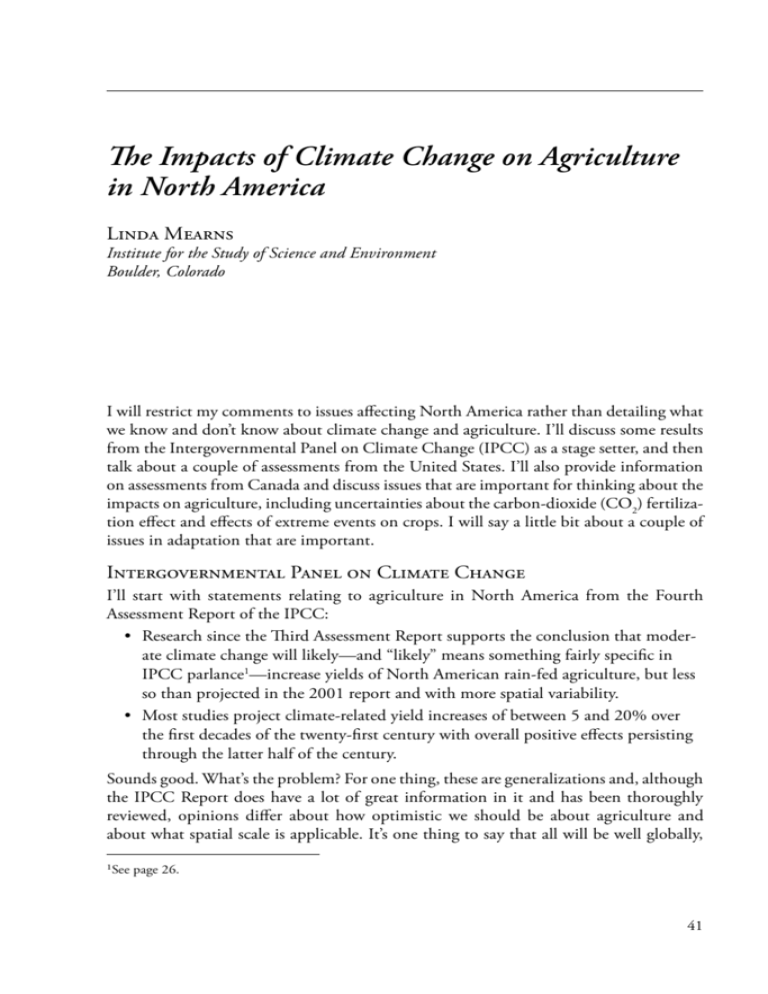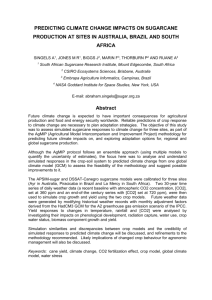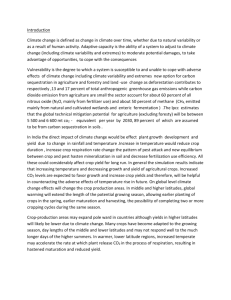The Impacts of Climate Change on Agriculture in North America
advertisement

The Impacts of Climate Change on Agriculture in North America Linda Mearns Institute for the Study of Science and Environment Boulder, Colorado I will restrict my comments to issues affecting North America rather than detailing what we know and don’t know about climate change and agriculture. I’ll discuss some results from the Intergovernmental Panel on Climate Change (IPCC) as a stage setter, and then talk about a couple of assessments from the United States. I’ll also provide information on assessments from Canada and discuss issues that are important for thinking about the impacts on agriculture, including uncertainties about the carbon-dioxide (CO2) fertilization effect and effects of extreme events on crops. I will say a little bit about a couple of issues in adaptation that are important. Intergovernmental Panel on Climate Change I’ll start with statements relating to agriculture in North America from the Fourth ­Assessment Report of the IPCC: •Research since the Third Assessment Report supports the conclusion that moderate climate change will likely—and “likely” means something fairly specific in IPCC parlance1—increase yields of North American rain-fed agriculture, but less so than projected in the 2001 report and with more spatial variability. • Most studies project climate-related yield increases of between 5 and 20% over the first decades of the twenty-first century with overall positive effects persisting through the latter half of the century. Sounds good. What’s the problem? For one thing, these are generalizations and, although the IPCC Report does have a lot of great information in it and has been thoroughly reviewed, opinions differ about how optimistic we should be about agriculture and about what spatial scale is applicable. It’s one thing to say that all will be well globally, 1See page 26. 41 but it’s another thing to say what’s going to happen to a particular farmer in southern Saskatchewan, for example. I won’t deal with tropical agriculture in detail, but many studies indicate that the positive effects of climate change will be less marked in the tropics than in temperate agriculture. One of the conclusions of the Fourth Report and others is that, in the tropics, we will see yield losses even with small changes in temperature. Farmers’ Options Let’s look at wheat, which is important to large swaths of North America. At least two options are open to farmers in adapting to climate change to maximize benefits from thermal resources: change the planting date and/or the variety. Sometimes increased irrigation is also an option. For a 1 or 1.5°C increase, we could see yield increases. But it’s noteworthy that there is a great deal of scatter in these results. It’s important for us at this conference, specifically, to address these uncertainties because they end up making a big difference in terms of how we potentially adapt. A 2004 government report summarizing climate-change issues for Canada is applicable to most temperate regions. One of those issues is increased insect infestation of crops. Others are increased weed growth and disease. Studies now are in progress to elucidate the effects of competing weeds and diseases as well as insects. In Canada, increased productivity may be expected from warmer temperatures, especially if the winter-wheat belt moves further north. However, many issues are unresolved. And a 2007 report on how climate change will affect agriculture in the Canadian prairies stated, “The net impacts are not clear and depend heavily on assumptions including the effectiveness of adaptation.” This bring us back to the topic of this meeting: adaptation may have tremendous effects in terms of crop yields, agricultural economics and food security. Modus Operandi The 2001 US National Assessment provides a convenient example of how we go about studying this. Older global-climate models predict that annual mean temperatures will increase and incrementally so into the future. So one starts with these types of climate changes and then uses them to drive crop models. One study used the EPIC group of models. With the level of CO2 kept at the baseline condition, in this case 365 parts per million (ppm)—known as the “climate change only effect”—increases in yield were predicted in northern areas and some decreases in the south. However, when the CO2fertilization effect was included, in general things became more positive with larger increases in yield. These yield changes for all major economically important crops are put into agricultural economic models, which was done for the US Assessment. These models are highly complex. Considering the 2030s and 2090s, yield increases were projected for both, with economic benefit. Again, what’s the problem? For one thing, if we look at a different model, one from the Canadian Climate Center, which had some larger decreases in precipitation, it projected decreases in economic benefit for the whole of the United States in the 2030s. Clearly, uncertainty in the climate is important. 42 Adapting Agriculture to Climate Change Experimental Approach The above studies were dependent on crop models driven by climate-change information. The US Climate Change Science Program in 2008 released a report on the impact of climate change on agriculture, water resources, etc. Rather than approaching this from a climate-modeling perspective—which has been a dominant method—it looked more at things from an experimental point of view, which is an interesting contrast. In general, compared to the results from the IPCC, the projection was less optimistic, particularly regarding the direct effects of CO22. These analyses are tending to become more and more current. Fifteen years ago, the focus was on what to expect in the year 2100. Now there’s more emphasis on the next 25 years, which is an indication of how much more seriously the problem is being taken. It’s no longer an academic exercise. In the 2008 report, they looked at a relatively small temperature change—1.2°C—and a CO2 increase of up to 440 ppm, i.e. conditions that are possible within the next 25 to 50 years. Data from newer experiments, indicated that some of the crop-modeling results may be optimistic about the CO2-fertilization effects on biomass and yield. For example, with a doubling of CO2 crop-modeling experiments had predicted a 10% increase, when, in fact, only a 4% increase now appeared to be realistic. So, more uncertainty. Table 1 provides US results for the effects of a 1.2°C rise in temperature plus CO2 fertilization from experiments with which they developed statistical relationships. The corn and soybean data are from the upper Midwest. Corn’s slightly positive response to increased CO2 resulted from improved water-use efficiency; however an overall 3% decrease occurred under these conditions due to adverse effects of increased temperature. Soybean was the only crop to respond positively to the increased temperature. Overall, the C4 species, corn and sorghum, were adversely affected; although the C3 species responded positively, things are now not looking as positive. Table 1. Effects of increases in temperature (of 1.2°C) and CO2 (to 440 ppm) on crop yields (Hatfield et al., 2008) Crop Effect of temperature Effect of CO2 Effect of both Corn –4.0 +1.0 –3.0 Soybean +2.5 +7.4 +9.9 Rice –12 +6.4 +5.6 Sorghum –9.4 +1.0 –8.4 Cotton –5.7 +9.2 +3.5 Wheat –6.7 +6.8 +0.1 2In general terms, higher atmospheric CO2 concentrations are expected to increase photosynthetic rate and improve water-use efficiency, thus increasing crop yields. Mearns 43 CO2 Fertilization Research on the effects of increased atmospheric CO2 has been on-going since the early 1980s. Although it was one of the first aspects of greenhouse-gas research to be explored, basic uncertainties remain. In 2006, Stephen Long and colleagues suggested that older enclosure studies had affected the environment more than recent FACE3 experiments and given overly optimistic indications of the effects of CO2 fertilization, hence global food security might be more threatened than had been projected. In 2007 several groups looked at this. Francesco Tubiello and colleagues (2007) re-analyzed the data of Long et al., and concluded that the simulated crop responses to elevated CO2 as implemented in key crop models were consistent with the FACE results. Ziska and Bunce (2007) emphasized the importance of quantifying uncertainties, so that rather than taking results from a curve-fitting we look at the uncertainty around the curve. This debate hasn’t been resolved, but it is important with respect to whether or not CO2-fertilization can offset decreases due to increased temperatures. Extreme Events Extreme events in agriculture is a topic that has received particular emphasis in the past 10 years. For example, the drought in the Canadian prairies in 2001–2002 caused losses in agricultural production equivalent to $3.6 billion, with Alberta and Saskatchewan particularly affected. Net farm income was negative for several provinces. However—and this occurs in crop-modeling studies as in reality—the adaptation measures could not completely mitigate the drought impact. This demonstrates that, even in advanced western society, increased adaptive capacity will be important. Another example is the European heat-wave of 2003. I was living in Italy and had never seen so many fields of corn completely desiccated; they lost 36% of their yield. France’s 2003 corn crop was 30% lower than in 2002. Wine production was the lowest in 10 years, and economic losses to the EU totaled €13 billion. This is important, because when we talk about adaptation, it is usually over the long term, whereas adapting to these kinds of extreme events is much more challenging. In the spring of 2008, parts of the Mississippi River were 7 feet above the flood stage, inundating thousands of acres of cropland and resulting in agriculture losses of $8 ­billion. Uncertainty A few years ago, we looked at a higher resolution climate-change scenario, using a regional climate model vs. the Australian global model. The global model drove the regional model. The higher-resolution scenario was much more draconian: precipitation decreases were greater compared to those predicted by the coarse-resolution model. And we used other regional modeling results for the United States. For soybean, large differences were found; yield decreases were predicted, particularly in the southeast, in both cases, but they are 3Free air CO2 enhancement. 44 Adapting Agriculture to Climate Change much more severe with the regional climate modeling. So, scale can make a difference. But, which do we believe? We don’t know. Adaptation An issue that has not been dealt with thoroughly for using crop-modeling studies is the pacing of adaptation. My colleague Bill Easterling, who is part of our southeast study, looked at what happens if you follow different types of curves, assuming that farmers do not all adapt at the same moment. What happens when adaptation occurs gradually as part of a process? The “no-adaptation” case was compared with the “clairvoyant” case in which farmers adapt immediately. Overall, as you would expect, results are somewhere in the middle. Very few studies have shown what adaptation would look like in real time. My colleague John Riley has studied factors affecting rate of adaptation. It is important to realize that variety development takes 8 to 15 years and variety adoption takes 3 to 14 years These processes have different time scales, therefore pacing of adoption of adaptation is important. References Hatfield J et al. (2008) Agriculture. In: The Effects of Climate Change on Agriculture, Land Resources, Water Resources, and Biodiversity. A Report by the U.S. Climate Change Science Program and the Subcommittee on Global Change Research. Washington, DC: US Climate Change Science Program. Long SP et al. (2006) Food for thought: Lower-than-expected crop yield stimulation with rising CO2 concentrations. Science 312 1918–1921. Tubiello FN et al. (2007) Crop response to elevated CO2 and world food supply. European Journal of Agronomy 26 215–223. Ziska LH Bunce JA (2007) Predicting the impact of changing CO2 on crop yields: Some thoughts on food. New Phytologist 175 607–618. Mearns 45 Linda Mearns is director of the Weather and Climate Impacts Assessment Science Program within the Institute for the Study of Society and the Environment (ISSE), and senior scientist at the National Center for Atmospheric Research, Boulder, Colorado. She served as director of ISSE for 3 years ending in April 2008. She has a PhD in geography/climatology from the University of California at Los Angeles. Her published research is mainly in ­climate-change scenario formation, quantifying uncertainties, and climate-change impacts on agro-ecosystems. She has most recently published papers on the effect of uncertainty in climate-change scenarios on agricultural and economic impacts of climate change, and quantifying uncertainty of regional climate change. She contributed to the Intergovernmental Panel on Climate Change 1995, 2001, and 2007 Assessments regarding climate variability, impacts of climate change on agriculture, regional projections of climate change, climate scenarios, and uncertainty in future projections of climate change. For the 2007 report she was lead author for the chapters on Regional Projections of Climate Change in Working Group 1 and New Assessment Methods in Working Group 2. Dr. Mearns is a member of the National Research Council Climate Research Committee and of the Human Dimensions of Global Change Committee. She was made a fellow of the American Meteorological Society in January 2006. 46 Adapting Agriculture to Climate Change








